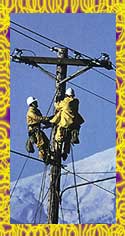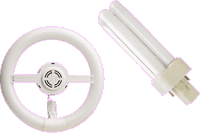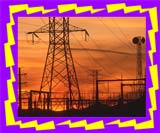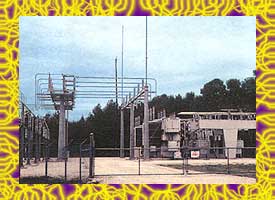![]()
Amperage,
amps
A measurement of the amount of
electric current.
Atom
 The
smallest unit of matter. Scientists so far have found 112
different kinds of atoms. Everything in the world is made of
different combinations of these atoms.
The
smallest unit of matter. Scientists so far have found 112
different kinds of atoms. Everything in the world is made of
different combinations of these atoms.
Biomass
Organic materials, such as wood by-products and agricultural
wastes, that can be burned to produce energy or converted
into a gas and used for fuel.
Conductor
Something that allows electricity to flow through it easily.
Water and most metals are good conductors. Conductors can
allow electricity to flow through them because the electrons
in their atoms move between atoms very easily.
Current
The movement or flow of electricity.
 Distribution
Lines
Distribution
Lines
Power lines that carry electricity through towns and
neighborhoods to homes and businesses. Distribution lines
can run overhead or underground.
Electricity
The flow of electrons.
Electron
The basic particle that orbits the nucleus of an atom. The
flow of electrons produces electricity.
Energy
The ability to do work. People get energy from food. Your
toaster and your washing machine get their energy from
electricity.
Fission
The splitting apart of an atom's nucleus, releasing a large
amount of heat energy.

Fluorescent
bulb
A light bulb that emits light because the gas inside it
glows when it is charged by electricity.
Fuel
cell
A technology that produces electricity through a chemical
reaction similar to that found in a battery.
Generator
A machine that converts mechanical energy into electrical
energy.
 Geothermal
energy
Geothermal
energy
Energy that is generated by converting hot water or steam
from deep beneath the Earth's surface into
electricity.
Hydroelectricity
Electricity that is generated when falling water makes a
turbine spin.
Insulator
Something that does not allow electricity to flow through it
easily. Glass and special rubber are good insulators.
Insulators do not allow electricity to flow through them
easily because the electrons in their atoms do not move
easily from atom to atom.
 Incandescent
bulb
Incandescent
bulb
A light bulb that emits light due to the glowing of a heated
filament inside it.
Kilowatt
1,000 watts of electricity.
Kilowatt/hour
One kilowatt of electricity produced or used in one
hour.
Megawatt
1,000,000 watts of power or 1,000 kilowatts.
 Natural
gas
Natural
gas
A gas used as a fuel, which is formed naturally in the earth
when organic material decomposes under pressure.
Neutron
A basic particle in an atom's nucleus that has a neutral
electrical charge.
Nucleus
The center of an atom. The nucleus contains tiny particles
called protons and neutrons. Orbiting around the nucleus are
electrons.
Photovoltaic
cell
A device that changes sunlight
directly into electricity.
Power
plant
A place where electricity is generated.
 Power
line
Power
line
A wire used to carry electricity.
Power lines are located high overhead or buried
underground.
Proton
A basic particle in an atom's
nucleus that has a positive electrical charge.
 Solar
energy
Solar
energy
Electricity produced from the
sun's radiation.
Substation
A facility where transformers
lower electricity's voltage.

Transformer
A device used to increase or
decrease electricity's voltage and current.

Transmission
lines
Power lines that carry
high-voltage electricity long distances.
Turbine
A device used in the generation
of electricity. It has a shaft with blades at one end and
electromagnets at the other. Water or steam or some other
energy source pushes the blades, which make the shaft and
the magnets spin very fast. The magnet end is surrounded by
heavy coils of copper wire, and the spinning magnets cause
electrons in the wire to begin to move, creating
electricity.
Utility
A company or other organization
that provides a public service, such as supplying
electricity, natural gas, or water.
Voltage,
volts
A measure of the pressure under
which electricity flows.
Wattage,
watts
A measure of the amount of work
done by a certain amount or amperage of electric current at
a certain pressure or voltage.